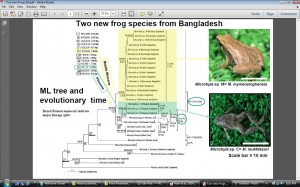We provide an updated phylogenetic hypothesis for the genus Microhyla, or oriental tiny frogs. An exhaustive taxonomic sampling for this group is challenging due to the high number of narrow-ranged or point-endemic species across South and Southeast Asia. In the present study, we examine mtDNA and nuDNA markers for 48 of 50 recognized Microhyla species (96%), including 12 nominal species and several undescribed candidate species that have not been examined phylogenetically before our work, thus providing the most comprehensive taxonomic sampling for Microhyla to date.
[Thanks to Nick and his student V. A. Gorin.]






